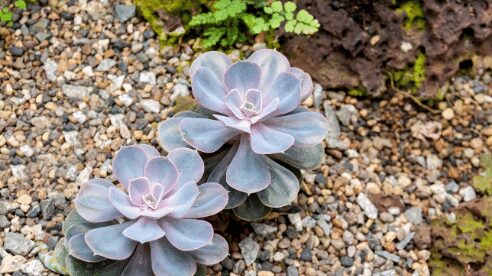Know in one minute about Purple pearl echeveria
|
Introduction
Echeveria is a large genus, of about 150 species and over a thousand cultivators. These plants come are more popular due to their stunning shapes and colors. They are easy to care and many produce attractive orange, yellow, and red flowers several times a year. Echeveria is native to Mexico and Central and South America and is available in a wide range of varieties and cultivars. Purple pearl echeveria is one of the most attractive succulents. This plant loves sunlight so the more sun exposure it gets, the more colorful it produces.
How to take care of Purple pearl echeveria
Echeveria ‘Purple Pearl’ is an eye-catching, popular succulent because its attractive purple rosettes make it grow as a houseplant. These beautiful rosettes can grow up to 12 inches (30 cm) in diameter.
It has fleshy, broad, slightly round, and perfect symmetry leaves. The colors are ranging from olive green to lavender-rose and decorated with pink-purple shade. This gorgeous plant produces coral pink, bell-shaped flowers (30 cm) in summer and fully grown in just 2 years. The propagation and care are very easy but keep remembering that this plant needs lots of sunshine and lots of fresh air.
1. Soil
It prefers sandy, porous soil which drains quickly and helps to prevent moisture from rotting the roots.
2. Light
This plant loves the sun and tolerates partial shade to maintain their colors and compact rosette form. If you want to keep this plant indoors, place it on a south-facing or east-facing window to prevent paleness and stretch out to look for more light. Whereas baby plants cannot handle intense heat or sun but need bright light so keep in shade to prevent sun damage.
3. Water
It is very important to note that while watering the plant water the soil and not the rosette. No need to water regularly irrigate only when the topsoil dries completely. Suspend watering during the dormant winter period. Avoid overwatering because it may cause rotting root rot or fungal diseases that can cause the plant to die.
4. Fertilizer
Applying a mild fertilizer solution from spring to the early fall season, helpful for its growth and stop feeding during winter.
5. Repotting
Repot the Echeveria Purple Pearl Succulent during early spring or summer time but make sure the soil is dry before repotting.
6. Temperature
They will not survive a hard frost, so take them indoors when the night temperature is down.
Purple pearl echeveria propagation
Purple pearl echeveria can be easily developed from seeds, leaves, stem cuttings, and even offsets (baby plants) it produces. These have to be dried or let callus for a few days until the wound has closed and placed on soil or in water and waits for roots to develop.
Toxic to cat and dog?
This cactus does not generally harm pets but takes precautions because they are not edible.
Types of echeveria with details of their appearance
1. Painted Echeveria (Echeveria nodulosa)
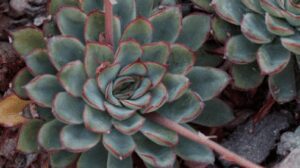
Painted Echeveria is an attractive evergreen flowering plant in the Crassulaceae family. It contains fleshy, pointed, curved in apple-green leaves that are marked with purplish-red stripes on both margins and mid-leaf. The stems grow up to 2 feet long with 5 inches wide rosettes (12 cm). This plant produces the daughter plant around the base of the mother plant. In summer the plant bears pale yellow flowers with pinkish-red markings.
2. Ghost Echeveria (Echeveria lilacina)
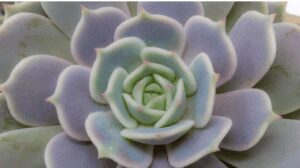
Ghost echeveria is attention-grabbing, open, spoon-shaped rosettes, and contains unique lavender grey color under more intense lighting. It is slow-growing and can grow to be 6 to 10 inches tall. It is easy to propagate, easy to maintain plants that produce dazzling colors and flowers (pale pink or coral pink).
3. Echeveria Topsy Turvy (Echeveria runyonii)
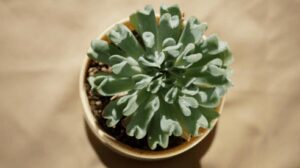
Echeveria topsy turvy is a spectacular fast-growing plant that is easy to grow. It is ideal as an indoor and outdoor plant even for beginner gardeners. This plant contains spoon-shaped, blue-green/gray leaves that point to the center of the rosette, giving them a curved appearance. The flowers are orange and yellow which produce in summer or fall and will reach the height of around 8 inches. The plant easily produces offsets that create a dense, waxy carpet thus suitable as a ground cover or in rock gardens.
4. Echeveria ‘Black Prince’
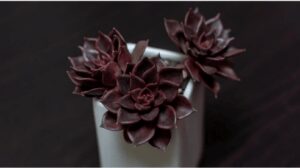
Echeveria Black Prince is also known as Echeveria ‘Bess Bates’ or Black Hens and Chicks. This is evergreen, slow-growing, a darkly-colored succulent that forms rosettes up to 3 inches (7.5 cm) wide.
It contains triangular fleshy leaves that are dark purple to black with surrounding a glowing green center. Echeveria Black Prince also comes in shades ranging from deep green, red, and purple to dark brown and charcoal. This plant requires low water and maintenance to grow, which makes them ideal for beginner gardeners. In late fall and early winter, this plant produces beautiful bell-shaped, scarlet red flowers that emerge on tall flower stalks. They readily produce offsets (babies) which grow from the bottom, growing upward against the mother plant.
5. Echeveria Mexican Snowball (Echeveria elegans)
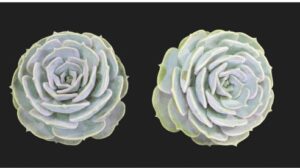
Echeveria Mexican Snowball was also known as Hens and Chicks, Mexican snowball, Mexican gem, white Mexican rose, and pearl echeveria. It is a famous evergreen succulent that contains fleshy, round, and cupped leaves with silvery green or blue-gray, compact rosette. It produces showy pink, yellow-tipped flowers on a tall pinkish-red stem during the late winter and spring seasons.
Q&A
How do you care for a Purple Pearl Echeveria?
To obtain echeveria healthy we need some right conditions such as light, water when dry, well-drained, and porous soil. Moreover, feeding the plant with a good fertilizer is helpful for its growth, and repotting is necessary to rejuvenate new plants.
Why are my succulents turning purple?
If succulent turning purple it means the plant is stressed. This may be due to the sunburn or from suddenly getting the extra light. During stress anthocyanin and carotenoid pigment produced by the succulents. These pigments induce beautiful color and protect them from getting damaged by the sun’s strong UV rays.
How do I know if my Echeveria is healthy?
When your plant can produce a flower that means your plant is healthy. It needs a lot of energy for plants to produce flowers from the center of the plant in summer.
Is Purple Heart a succulent?
Yes, Purple Heart (Tradescantia Pallida) is very popular with fuzzy, purple, lance-shaped leaves succulent-stemmed plants.
How do you tell if a succulent is overwatered?
The overwatered plant turns yellow and puffy-looking stems or leaves and feels moist or mushy to the touch. Later overwatered leaves change their color to brown or black and the plant will suffer from fungal disease.
